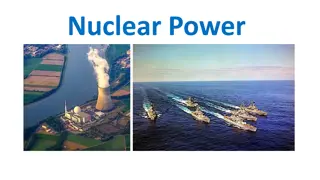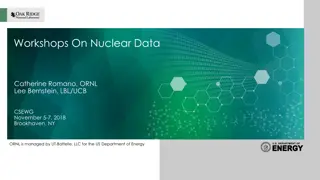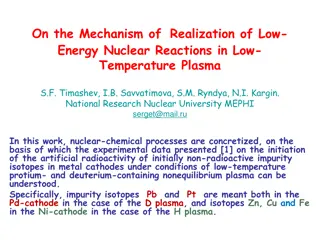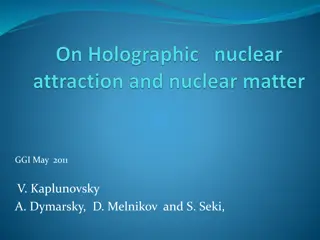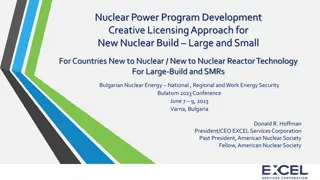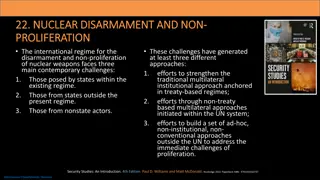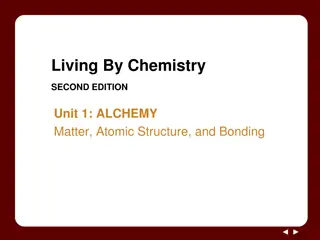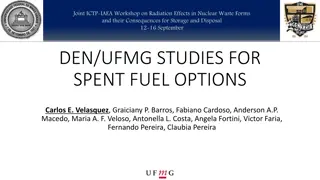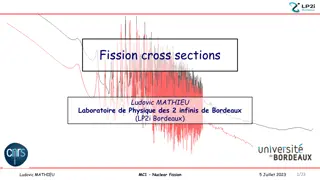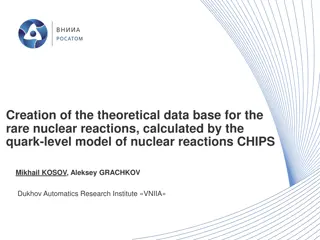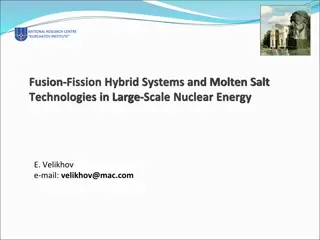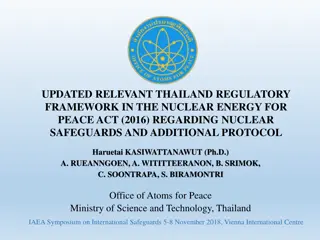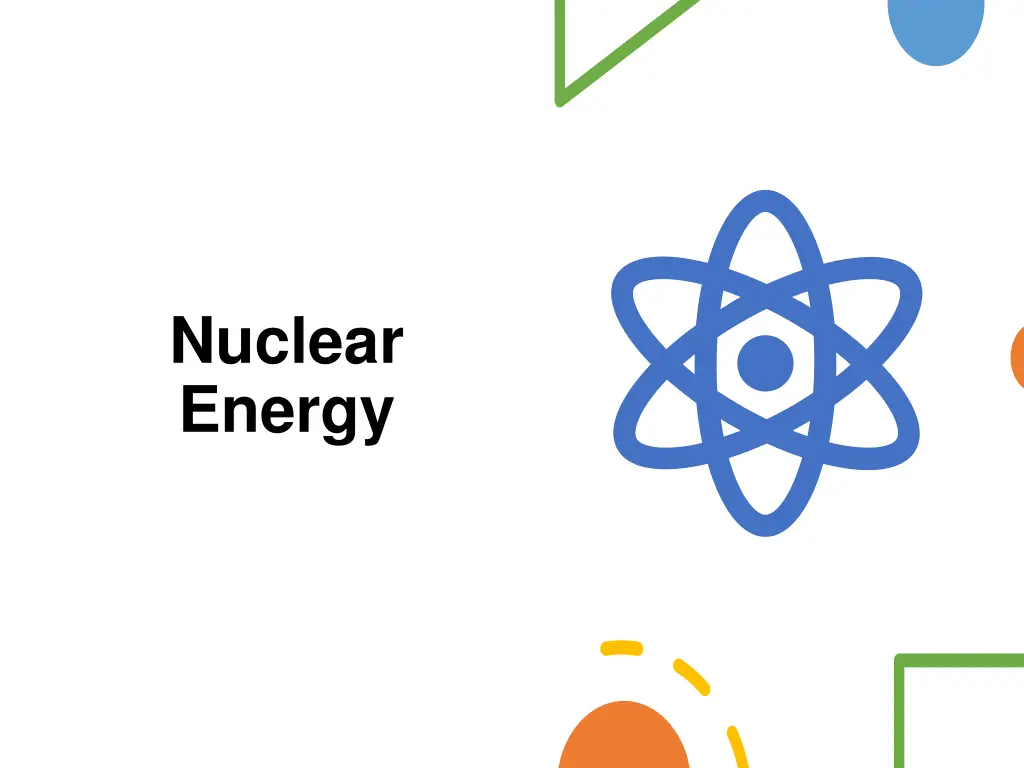
Understanding Nuclear Energy and Properties
Explore the fascinating world of nuclear energy and properties, including the discovery of the nucleus, atomic structure, and mass numbers. Learn about the unique characteristics of nuclei, atomic masses in units, and energy release in nuclear reactions. Delve into examples to calculate effective radius and mass excess for different elements like hydrogen, krypton, and silver.
Uploaded on | 1 Views
Download Presentation

Please find below an Image/Link to download the presentation.
The content on the website is provided AS IS for your information and personal use only. It may not be sold, licensed, or shared on other websites without obtaining consent from the author. If you encounter any issues during the download, it is possible that the publisher has removed the file from their server.
You are allowed to download the files provided on this website for personal or commercial use, subject to the condition that they are used lawfully. All files are the property of their respective owners.
The content on the website is provided AS IS for your information and personal use only. It may not be sold, licensed, or shared on other websites without obtaining consent from the author.
E N D
Presentation Transcript
Nuclear Energy
Discovery of the Discovery of the Nucleus Nucleus In 1911 Ernest Rutherford proposed that the positive charge of the atom is densely concentrated at the center of the atom, forming its nucleus, and that, furthermore, the nucleus is responsible for most of the mass of the atom.
Some Nuclear Some Nuclear Properties Properties Nuclei are made up of protons and neutrons. The number of protons in a nucleus is called the atomic number of the nucleus, and is represented by the symbol Z; the number of neutrons is the neutron number, and is represented by the symbol N. The total number of neutrons and protons in a nucleus is called its mass number A. Neutrons and protons, when considered collectively, are called nucleons.
Some Nuclear Properties Some Nuclear Properties The nucleus, like the atom, is not a solid object with a well-defined surface. Although most nuclides are spherical, some are notably ellipsoidal. Electron-scattering experiments (as well as experiments of other kinds) allow us to assign to each nuclide an effective radius given by the equation to the right, where A is the mass number and r0 =1.2 fm.
Some Nuclear Properties Some Nuclear Properties Atomic masses are often reported in atomic mass units, a system in which the atomic mass of neutral 12C is defined to be exactly 12 u, where 1 u =1.660 538 86 10-27 kg. The mass number A of a nuclide gives such an approximate mass in atomic mass units. For example, the approximate mass of both the nucleus and the neutral atom for 197Au is 197 u, which is close to the actual atomic mass of 196.966 552 u. If the total mass of the participants in a nuclear reaction changes by an amount m, there is an energy release or absorption given by Q=mc2. The atom s mass excess, , is defined by the equation on the right. Here, M is the actual mass of the atom in atomic units, and Ais the mass number for that atom s nucleus.
Example Problem Example Problem Using the table below determine the effective radius and mass excess for hydrogen (H), krypton (Kr), and silver (Au). Remember that For hydrogen: r = (1.2 x 10-15)*(1)1/3 = 1.2 x 10-15 = 1.007825-1 = 0.007825 For krypton: r = (1.2 x 10-15)*(84)1/3 = 5.26 x 10-15 = 83.911507-84 = -0.088493 For silver: r = (1.2 x 10-15)*(197)1/3 = 6.98 x 10-15 = 196.966552-197 = -0.033448
Example Problem Example Problem Using the table below determine the effective radius and mass excess for hydrogen (H), krypton (Kr), and silver (Au). Remember that For hydrogen: r = (1.2 x 10-15)*(1)1/3 = 1.2 x 10-15 = 1.007825-1 = 0.007825 For krypton: r = (1.2 x 10-15)*(84)1/3 = 5.26 x 10-15 = 83.911507-84 = -0.088493 For silver: r = (1.2 x 10-15)*(197)1/3 = 6.98 x 10-15 = 196.966552-197 = -0.033448
Example Problem Example Problem Using the table below determine the effective radius and mass excess for hydrogen (H), krypton (Kr), and gold (Au). Remember that For hydrogen: r = (1.2 x 10-15)*(1)1/3 = 1.2 x 10-15 = 1.007825-1 = 0.007825 For krypton: r = (1.2 x 10-15)*(84)1/3 = 5.26 x 10-15 = 83.911507-84 = -0.088493 For gold: r = (1.2 x 10-15)*(197)1/3 = 6.98 x 10-15 = 196.966552-197 = -0.033448
Nuclear Binding Energy Nuclear Binding Energy If the nucleus splits into two nuclei, the process is called fission, and occurs naturally with large high mass number nuclei. If a pair of nuclei were to combine to form a single nucleus, the process is called fusion, and occurs naturally in stars.
Radioactive Decay Radioactive Decay The decay rate is defined as, The half life-time (T1/2) is the time at which both N and R have been reduced to one-half their initial values and is the decay energy. Here is the mean life-time, which is the time at which bothN and R have been reduced to e-1of their initial values.
Alpha Decay Alpha Decay When a nucleus undergoes alpha decay, it transforms to a different nuclide by emitting an alpha particle (a helium nucleus, 4He). For example, when uranium 238U undergoes alpha decay, it transforms to thorium 234Th: The disintegration energy, Q, for the decay above is 4.25. The potential energy shown in the figure below is a combination of the potential energy associated with the (attractive) strong nuclear force that acts in the nuclear interior and a Coulomb potential associated with the (repulsive) electric force that acts between the two particles (234Th and 4He) before and after the decay has occurred.
Beta Decay Beta Decay A nucleus that decays spontaneously by emitting an electron or a positron (a positively charged particle with the mass of an electron) is said to undergo beta decay. Like alpha decay, this is a spontaneous process, with a definite disintegration energy and half-life. (b- decay) (b+ decay) Examples: Here, n is a neutrino, a neutral particle which has a very small mass, that is emitted from the nucleus along with the electron or positron during the decay process. In a beta decay the energy of the emitted electrons or positrons may range from zero up to a certain maximum Kmax, since, unlike the alpha decay, the Q energy is shared by two components.
Beta Decay and the Beta Decay and the Neutrino Neutrino Wolfgang Pauli first suggested the existence of neutrinos in 1930. Billions of them pass through our bodies every second, leaving no trace. Despite their elusive character, neutrinos have been detected in the laboratory.
Nuclear Fission Nuclear Fission The most probable mass numbers, occurring in about 7% of the fission events, are centered around A ~95 and A~140.
Nuclear Fission Nuclear Fission The energy released by the fission, Q, is: For a high-mass nuclide (A ~240), the binding energy per nucleon is about 7.6 MeV/nucleon. For middle-mass nuclides (A~120), it is about 8.5 MeV/nucleon. Thus, the energy released by fission of a high-mass nuclide to two middle-mass nuclides is
Nuclear Reactors Three main difficulties stand in the way of a working reactor: 1. The Neutron Leakage Problem: Some neutrons produced by fission leak out from the reactor. 2. The Neutron Energy Problem: Fast neutrons are not as effective in producing fission as slower thermal neutrons. 3. The Neutron Capture Problem: Non-fission capture of neutrons
Nuclear Fusion For controlled terrestrial use one could consider two deuteron deuteron (d-d), and one deuteron-tritium reactions: Three requirements for a successful thermonuclear reactor can be considered: 1. High Particle Density 2. High Plasma Temperature 3. Long Confinement Time For the successful operation of a thermonuclear reactor using the d-t reaction, it is necessary to have Lawson s Criterion:
Nuclear Fusion 1. Magnetic Confinement a. A suitably shaped magnetic field is used to confine the hot plasma in an evacuated doughnut-shaped chamber called a tokomak. The magnetic forces acting on the charged particles that make up the hot plasma keep the plasma from touching the walls of the chamber. b. The plasma is heated by inducing a current in it and by bombarding it with an externally accelerated beam of particles. The first goal of this approach is to achieve breakeven, which occurs when the Lawson criterion is met or exceeded. c. The ultimate goal is ignition, which corresponds to a self-sustaining thermonuclear reaction and a net generation of energy. 2. Inertial Confinement a. A second approach, involves zapping a solid fuel pellet from all sides with intense laser beams, evaporating some material from the surface of the pellet. This boiled-off material causes an inward-moving shock wave that compresses the core of the pellet, increasing both its particle density and its temperature. The fuel is confinedto the pellet and the particles do not escape from the heated pellet during the very short zapping interval because of their inertia . b. Laser fusion, using the inertial confinement approach, is being investigated in many laboratories in the United States and elsewhere.



